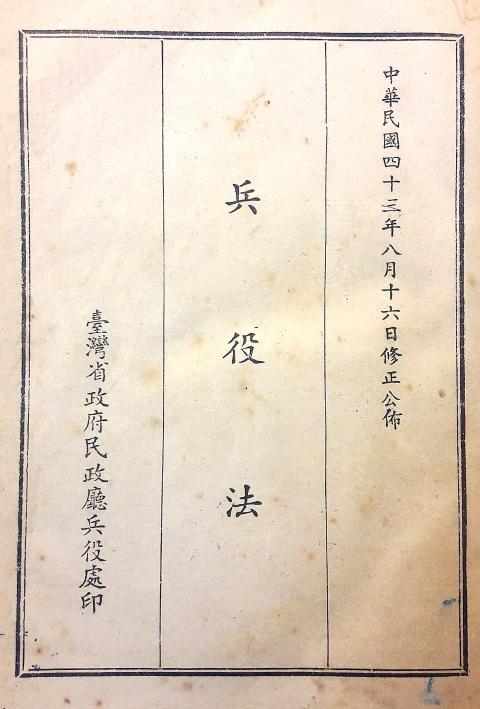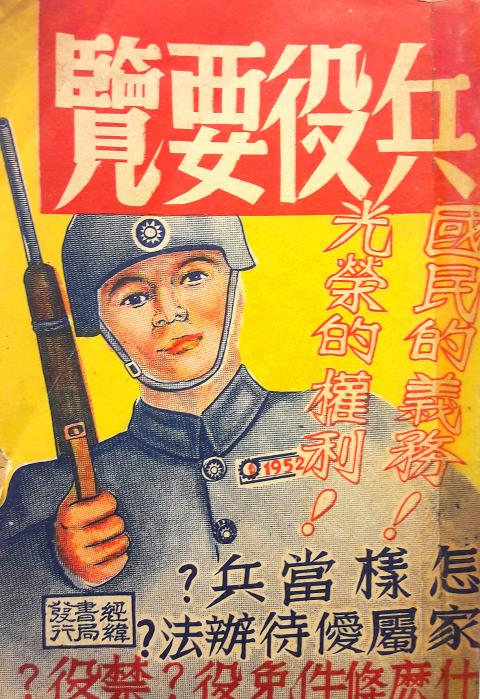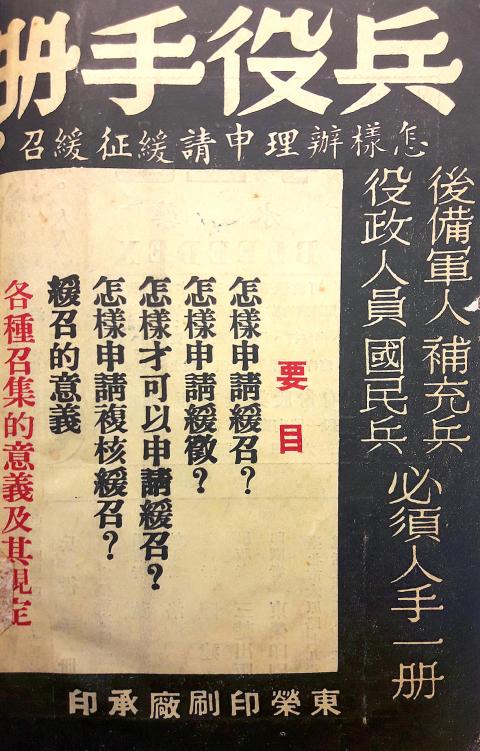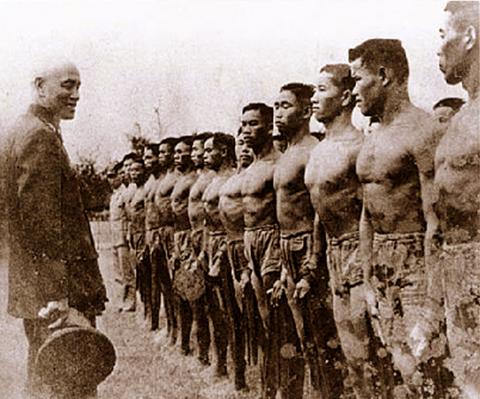July 24 to July 30
Public resentment exploded when the conscription order came down in February 1946. The last time Taiwanese faced formal conscription was during World War II, when the Japanese colonial government drafted more than 20,000 men in 1945. They formally enlisted in the Imperial Japanese Army in January, just to catch the tail end of the war.
Already unhappy with the lack of discipline of the 30,000 Chinese Nationalist Party (KMT) troops in Taiwan, the people refused to accept governor-general Chen Yi’s (陳儀) plan to send their young men to fight the Communists in China, writes Chen Shih-chang (陳世昌) in 70 Years After the War: A History of Taiwan (戰後70年台灣史).

Photo: Han Cheung, Taipei Times
“The argument was that forced conscription was illegal because China and Japan hadn’t signed a treaty yet,” Chen Shih-chang writes, adding that the people told Chen Yi they would protect their homeland while the 30,000 KMT troops headed to China. Chen Yi scrapped the plan.
FIRST CONSCRIPTS
Times were different by the time the second order was issued on July 25, 1951. The KMT had lost China to the Communists and completely retreated to Taiwan, where they set up an authoritarian regime under martial law.

Photos: Han Cheung, Taipei Times
There was no refusing this time. The plan was to draft 14,000 soldiers and 1,000 drivers, writes historian and journalist Hsu Tsung-mao (徐宗懋) in 20th Century Taiwan: Retrocession (20世紀台灣:光復篇), but only about 12,000 reported for duty.
Of course, the official rhetoric back then states that the government was doing the people a service.
An outline for conscription policy published in 1949 states: “Since 1945, the central government has exempted all Taiwanese from conscription out of sympathy for the 50 years of oppression they’ve suffered under the Japanese. But most knowledgeable people know that military service is the duty of all citizens. The people have expressed hope that the government implement conscription soon so that local young men can channel their patriotic passion.”

Photo: Han Cheung, Taipei Times
Modern sources tell a different story. A Public Television Service News Network (公視新聞議題中心) article states that the KMT sought to reduce their sky-high defense budget by encouraging professional soldiers to retire and replace them with conscripts.
The state-run Central Daily News (中央日報) ran several editorials warning Taiwanese of the horrors of Communism and why they should fight for the KMT.
“Perhaps there are still people in Taiwan who do not feel as much hatred for the enemy because they have not witnessed the brutality of the Communists, who have caused bloodbaths and mass enslavement in China,” the editorial states. “We need to sincerely inform them that millions in China once felt the same way … they didn’t believe in how venomous the Communists were until it was too late. The only way to avoid being attacked by poisonous snakes and ferocious beasts is to unite and kill them with our weapons. And the only way to save Taiwan from being soaked in blood and ravaged is to join the army, take up a rifle and join the decisive battle!”

Photo courtesy of Wikimedia Commons
After the order was issued, then-Taipei Mayor Wu San-lien (吳三連) announced that “our counterattack [against the Communists] will succeed, and therefore the future of Taiwanese youth will be in China. For the sake of their future, it is imperative for Taiwanese youth to join the fight.”
A SHARED EXPERIENCE
Hsu writes that the conscripts were to report to the camps on Aug. 12, with each locality holding festive farewell parties. In Tainan, the conscripts participated in a parade with professional soldiers as the crowd lit off firecrackers, following the troops until they got on the train. Yilan’s barber shops, public baths and movie theaters did not charge conscripts on that day.
The first night at camp, the conscripts learned several anti-communists songs prescribed by the government, including one personally rewritten and arranged by no other than former President Chiang Kai-shek (蔣介石).
From then on, military service became a shared experience for most males in Taiwan, unless they were either exempt or found a way to avoid service. In 1959, the criteria for conscription was broadened due to a shortage of troops. That same year, the practice began of having all males spend time at Chenggong Ling (成功嶺) training camp before they reported to college.
Chiang valued this training camp, often speaking at commencement and graduation ceremonies and delivering speeches to the students to make sure they had the “correct” attitude towards the country’s goals. More than 1.3 million Taiwanese went through this experience before it was abolished in 2000.
By 1974, the Executive Yuan announced that the number of men eligible for military service had far exceeded the needs of the military. Restrictions and requirements were continuously relaxed over the decades until the government announced that it would abolish the draft in favor of an all-volunteer army.
The date has been pushed back several times, the latest news coming in December when the Ministry of Defense announced that this year’s conscripts will be the nation’s final class.
Taiwan in Time, a column about Taiwan’s history that is published every Sunday, spotlights important or interesting events around the nation that have anniversaries this week.

On April 26, The Lancet published a letter from two doctors at Taichung-based China Medical University Hospital (CMUH) warning that “Taiwan’s Health Care System is on the Brink of Collapse.” The authors said that “Years of policy inaction and mismanagement of resources have led to the National Health Insurance system operating under unsustainable conditions.” The pushback was immediate. Errors in the paper were quickly identified and publicized, to discredit the authors (the hospital apologized). CNA reported that CMUH said the letter described Taiwan in 2021 as having 62 nurses per 10,000 people, when the correct number was 78 nurses per 10,000

As Donald Trump’s executive order in March led to the shuttering of Voice of America (VOA) — the global broadcaster whose roots date back to the fight against Nazi propaganda — he quickly attracted support from figures not used to aligning themselves with any US administration. Trump had ordered the US Agency for Global Media, the federal agency that funds VOA and other groups promoting independent journalism overseas, to be “eliminated to the maximum extent consistent with applicable law.” The decision suddenly halted programming in 49 languages to more than 425 million people. In Moscow, Margarita Simonyan, the hardline editor-in-chief of the

Six weeks before I embarked on a research mission in Kyoto, I was sitting alone at a bar counter in Melbourne. Next to me, a woman was bragging loudly to a friend: She, too, was heading to Kyoto, I quickly discerned. Except her trip was in four months. And she’d just pulled an all-nighter booking restaurant reservations. As I snooped on the conversation, I broke out in a sweat, panicking because I’d yet to secure a single table. Then I remembered: Eating well in Japan is absolutely not something to lose sleep over. It’s true that the best-known institutions book up faster

Though the total area of Penghu isn’t that large, exploring all of it — including its numerous outlying islands — could easily take a couple of weeks. The most remote township accessible by road from Magong City (馬公市) is Siyu (西嶼鄉), and this place alone deserves at least two days to fully appreciate. Whether it’s beaches, architecture, museums, snacks, sunrises or sunsets that attract you, Siyu has something for everyone. Though only 5km from Magong by sea, no ferry service currently exists and it must be reached by a long circuitous route around the main island of Penghu, with the